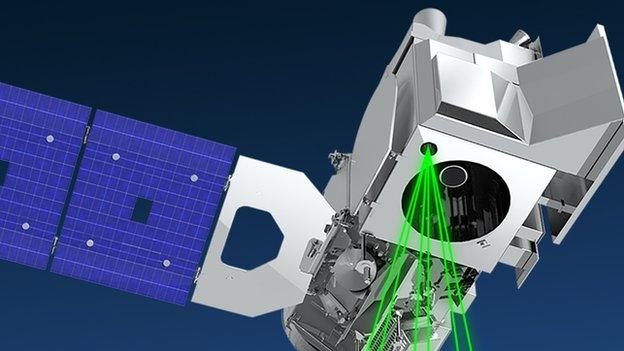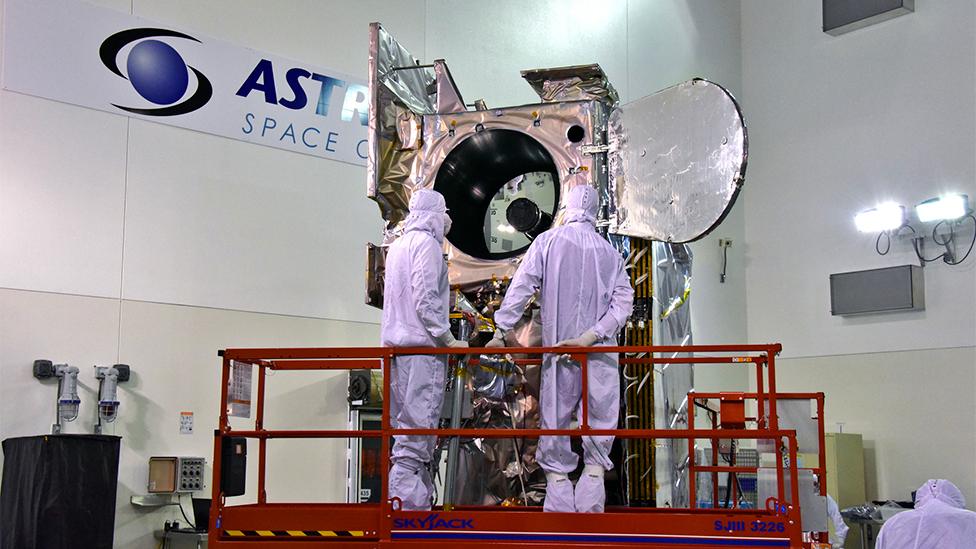ICESat will get unprecedented view of Earth's ice
- Published
Watch the Delta II rocket launch from Vandenberg Air Force Base in California
The American space agency has launched a laser into orbit to measure the condition of Earth's ice cover.
The satellite mission, called ICESat-2, should provide more precise information on how these frozen surfaces are being affected by global warming.
Antarctica, Greenland and the ice floating on the Arctic Ocean have all lost volume in recent decades.
ICESat-2 will track ongoing change in unprecedented detail from its vantage point some 500km above the planet.
The satellite was taken up by a Delta II rocket, flying out of Vandenberg Air Force Base in California.
As the name suggests, ICESat-2 is a follow-on project. The original spacecraft flew in the 2000s and pioneered the laser measurement of the height of polar glaciers and sea-ice from space. But the mission was plagued by technical problems that limited its observations to just a couple of months in every year.
Nasa has since re-modelled the technology, both to make it more reliable and to give it a sharper view.
"ICESat-2 is going to observe the cryosphere with a spatial resolution at the level we have never seen before from space," explained Prof Helen Fricker from the Scripps Institution of Oceanography.
"The beam is split across-track into six - three pairs - so we can map more of the ice surface as well as estimating the surface slope, which can confuse our interpretation of height changes.
"The orbit reaches to two degrees of the poles, and the same ground tracks are sampled every three months, giving us seasonal snapshots of ice height. From these data we can unravel the processes responsible for the ice loss in the polar regions," she told BBC News.

Artwork: ICESat-2 fires 10,000 shots a second as it moves around the Earth
Why is this mission important?
Antarctica and Greenland lose billions of tonnes of ice every year - the result largely of warm water being able to melt land glaciers where they meet the ocean. This wastage is slowly but surely pushing up sea-levels worldwide.
In the Arctic, the seasonal floes have also been in retreat. Sea-ice in the far north is thought to have lost two-thirds of its volume since the 1980s. And although this has no direct impact on the height of the oceans, the reduced ice-cover is working to amplify temperature rises in the region.
Much of the change that is occurring at the poles can present itself in quite subtle ways, says Dr Tom Neumann, Nasa's ICESat-2 deputy project scientist, and a very precise tool is needed to characterise it properly.
"An elevation change of just a centimetre over an ice sheet the scale of Antarctica represents a tremendous amount of water either gained to or lost by the ice sheet. 140 gigatonnes worth."
Tom Neumann: "IceSAT-2's laser is a totally different design"
How does ICESat-2 work?
Weighing half a tonne, the new laser system is one of the largest Earth-observation instruments ever built by Nasa. It uses a technique called "photon counting".
It fires about 10,000 pulses of light every second. Each of those shots goes down to the Earth and bounces back up on a timescale of about 3.3 milliseconds. The exact time equates to the height of the reflecting surface.
"We fire about a trillion photons (particles of light) in every shot. We get about one back," says Cathy Richardson, who works on the team at Nasa that developed the instrument.
"We can time that one photon when it comes back just as accurately as when it left the instrument. And from that we can calculate a distance to about half a centimetre on the Earth."
The laser is making a measurement every 70cm as it moves forward across the ice.

The $1bn mission is funded initially to run for three years
What new information will be revealed?
It is hoped that ICESat-2 can help produce the first robust maps of sea-ice thickness in the Antarctic. At the moment, the technique for assessing ice floes really only works in the Arctic.
It involves comparing the height of that part of the floating ice sticking above the water with the height of the ocean surface itself. Because scientists know the density of seawater and ice, they can then calculate how much ice must be submerged, and thus a total overall thickness.
In the Antarctic, though, this approach is problematic. In the far south, the ice floes can get covered in substantial dumps of snow. This will sometimes push the sea-ice fully under the water and confound the thickness calculation.
The proposed solution is to combine ICESat's laser observations, which reflect off the top of the snow surface, with those of radar satellites, whose microwave beams penetrate more deeply into the snow covering. This will reduce a lot of uncertainty.
Scientists need thickness measurements to properly access the status of floes. Sometimes the wind will spread the ice out; other times it will pile the ice up. The difference is only apparent when the ice is viewed in three dimensions.
And, no, the laser does not have the power to melt the ice from 500km up! But on a dark night you might just be able to see a green dot when ICESat flies overhead.
Jonathan.Amos-INTERNET@bbc.co.uk, external and follow me on Twitter: @BBCAmos, external